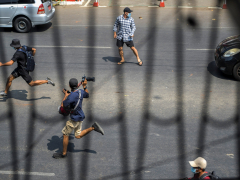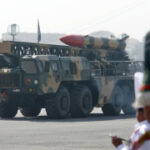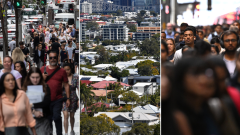On a typical day, Mai Rupa travels through his native Shan State, in eastern Myanmar, documenting the impact of war.
A video journalist with the online news outlet Shwe Phee Myay, he travels to remote towns and villages, collecting footage and conducting interviews on stories ranging from battle updates to the situation for local civilians living in a war zone.
His job is fraught with risks. Roads are strewn with landmines and there are times when he has taken cover from aerial bombing and artillery shelling.
“I have witnessed countless people being injured and civilians dying in front of me,” Mai Rupa said.
“These heartbreaking experiences deeply affected me,” he told Al Jazeera, “at times, leading to serious emotional distress.”
Mai Rupa is one of a small number of brave, independent journalists still reporting on the ground in Myanmar, where a 2021 military coup shattered the country’s fragile transition to democracy and obliterated media freedoms.
Like his colleagues at Shwe Phee Myay – a name which refers to Shan State’s rich history of tea cultivation – Mai Rupa prefers to go by a pen name due to the risks of publicly identifying as a reporter with one of the last remaining independent media outlets still operating inside the country.
Most journalists fled Myanmar in the aftermath of the military’s takeover and the expanding civil war. Some continue their coverage by making cross-border trips from work bases in neighbouring Thailand and India.
But staff at Shwe Phee Myay – a Burmese-language outlet, with roots in Shan State’s ethnic Ta’ang community – continue reporting from on the ground, covering a region of Myanmar where several ethnic armed groups have for decades fought against the military and at times clashed with each other.

Fighting to keep the public informed
After Myanmar’s military launched a coup in February 2021, Shwe Phee Myay’s journalists faced new risks.
In March that year, two reporters with the outlet narrowly escaped arrest while covering pro-democracy protests. When soldiers and police raided their office in the northern Shan State capital of Lashio two months later, the entire team had already gone into hiding.
That September, the military arrested the organisation’s video reporter, Lway M Phuong, for alleged incitement and dissemination of “false news”. She served nearly two years in prison. The rest of the 10-person Shwe Phee Myay team scattered following her arrest, which came amid the Myanmar military’s wider crackdown on the media.
Spread out across northern Shan State in the east of the country, the news team initially struggled to continue their work. They chose to avoid urban areas where they might encounter the military. Every day was a struggle to continue reporting.
“We couldn’t travel on main roads, only back roads,” recounted Hlar Nyiem, an assistant editor with Shwe Phee Myay.
“Sometimes, we lost four or five work days in a week,” she said.

Despite the dangers, Shwe Phee Myay’s reporters continued with their clandestine work to keep the public informed.
When a magnitude 7.7 earthquake hit central Myanmar on March 28, killing more than 3,800 people, Shwe Phee Myay’s journalists were among the few able to document the aftermath from inside the country.
The military blocked most international media outlets from accessing earthquake-affected areas, citing difficulties with travel and accommodation, and the few local reporters still working secretly in the country took great risks to get information to the outside world.
“These journalists continue to reveal truths and make people’s voices heard that the military regime is desperate to silence,” said Thu Thu Aung, a public policy scholar at the University of Oxford who has conducted research on Myanmar’s post-coup media landscape.

On top of the civil war and threats posed by Myanmar’s military regime, Myanmar’s journalists have encountered a new threat.
In January, the administration of US President Donald Trump and his billionaire confidante Elon Musk’s Department of Government Efficiency (DOGE) began dismantling the United States Agency for International Development (USAID).
USAID had allocated more than $268m towards supporting independent media and the free flow of information in more than 30 countries around the world – from Ukraine to Myanmar, according to journalism advocacy group Reporters Without Borders.
In February, The Guardian reported on how the freezing of USAID funds created an “existential crisis” for exiled Myanmar journalists.
The situation worsened further in mid-March, when the White House declared plans for the US Agency for Global Media (USAGM) to reduce operations to the bare minimum. USAGM oversees – among others – the Voice of America and Radio Free Asia, which were both leading providers of news on Myanmar.
Last week, RFA announced it was laying off 90 percent of its staff and ceasing to produce news in the Tibetan, Burmese, Uighur and Lao languages. VOA has faced a similar situation.
Tin Tin Nyo, managing director of Burma News International, a network of 16 local, independent media organisations based inside and outside Myanmar, said the loss of the Burmese-language services provided by VOA and RFA created a “troubling information vacuum”.
Myanmar’s independent media sector also relied heavily on international assistance, which had already been dwindling, Tin Tin Nyo said.
Many local Myanmar news outlets were already “struggling to continue producing reliable information”, as a result of the USAID funding cuts brought in by Trump and executed by Musk’s DOGE, she said.
Some had laid off staff, reduced their programming or suspended operations.
“The downsizing of independent media has decreased the capacity to monitor [false] narratives, provide early warnings, and counter propaganda, ultimately weakening the pro-democracy movement,” Tin Tin Nyo said.
“When independent media fail to produce news, policymakers around the world will be un





